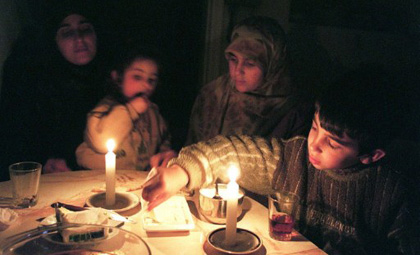
[Source]
A power plant cannot be run at full capacity without stopping for months on end. However, that is common practice in the sector. Machines need tune-ups and down time so they run efficiently and last longer. According to Executive magazine, Lebanon’s installed capacity for producing electricity is 2,100 megawatts (which is actually the same as average demand in 2010 during non-summer months – demand peaked at around 2,400 megawatts). Because of poor maintenance, Lebanon only generated around 1,500 megawatts that year. [NowLebanon]
So basically we need 2,400 megawatts with an average yearly increase in demand of 6-7%, and we only produce around 1,500 megawatts, meaning we lack some 900 megawatts for 24/7 electricity.
This being said, the government seemed to have reached a compromise by agreeing to rent power-generating vessels that will be able to generate as much as 270 megawatts per year. The lease agreement is for two-years, renewable for one year after its expiry and will cost us around $400 million.
In addition to renting vessels, the government will invest some $500 million over the next few years in building 1,500-megawatt power plants.
All in all, the electricity problem is going to get worse in the summer but will improve slightly by the end of the year if we do end up renting these vessels. As for the power plants, they will probably end up as another corruption file among Lebanese politicians.

[Source]










I loved the advertisement!!! Very creative and Funny:)
“they will probably end up as another corruption file among Lebanese politicians.” so typical lebanese, ALWAYS negative… ALWAYS! even if we have nuclear powered electricity we will still have something to complain abt it, thats not good in ANY case
nothing would be as efficient as Litani/Assi water dams…
“Roy” come on , u said complaint
I am 35 years old and I don’t remember in my whole life that we used to have 24 hours electricity. And now you want me to believe that’s its done.
Your remember the famous word of Abou Jamra in 1989 ” Point a la ligne” back 23 years
Complaint? come on Roy
Allow me to give some industry insights:
It costs roughly $1 million to produce 1 megawatt of electricity, which also costs around $100k/year for maintenance.
Power plants have a 90/10 working cycle, which means they operate 90% of the time and need 10% of downtime for maintenance. This translates into 11 months of operations per year.
If funds and location are available, it takes around 18 months to build a 500 megawatt plant ready to produce.
If properly maintained, a power plant will run 30 years at full capacity (even longer actually), and will produce the same amount of power 30 years down the line as it does on day 1.
The main problem that no one seems to be talking about is not just power generation, but the distribution grid which is old, inefficient, produces huge losses, as is incapable of meeting end user demand.
No way they resolve this crisis…They installed a parralel economy with ichtirak and if they stop now, all who sell ichtirak will complain!!
Another thing…have they heard about renewable energy?
Elections next May? You sheeple…Save this comment for that period. You still will have darkness in Lebanon in 2013. Some pol is going to jump up (Bassil) and say that he wanted Electricity for the Christians but the dastardly “other” parties stopped him. But who cares? Lebanese are great in talking. Like Jad said has anyone tried to have a comprehensive study to revamp the whole system? Billions of dollars spent and stolen and yet left with a system put together with toothpicks and band aid.
“and say that he wanted Electricity for the Christians” Gianni r u serious ? electricity for christians ? u stupid its for all, if the country falls into darkness christians AND muslims will fall together, if he succeeds u will have electricity if not ull stay in darkness, stop thinking like this for god’s sake i dont care if his poll jumps up who cares, dont vote for him enno in BOTH cases the ones who arent going to vote him wont do it whether he succeeds or not, so it doesnt have to do with elections pff
Rob,
Thank you for “raising” yourself and exposing your intellect. Thank you. You are right with your slogans regarding for all Lebanon. However, my point is beyond the slogans and declarations! Now we are hearing about kickbacks from the so called “electricity supply” ships to specific pols. Whatever happened to the Red diesel issue? You seem to be child trying to explain a man’s game. Great have fun at it; however insults will not get you far.
Lebanon and its elections are sectarian. Now please deny that! there are pockets in Lebanon where they have not paid Electricity bills for eons. Stop this nonsense that it is for all; without coming up with a comprehensive and feasible plan that can be implemented! Not to win votes in Jbeil or Batroun.
Again thank you for your insight.
i just told you i dont care about jebran bassil and about the elections wont vote for him anyway even if he gets nuclear powered electricity, all i care is i get a descent elect. it seems u dont want him to succeed because of sectarian reasons if not u wouldnt care for his elections purposes after all
do you THINK that people from the “other” party will vote for him if he succeeds??? I DONT THINK SO!!!
the ones who always vote for him will continue to vote for him, the ones who don’t, WONT vote for him no matter WHAT, this is the result of sectarian elections, if it wasn’t, people would vote according to their achievements, and yes i DO care about the diesel thing did i make that clear Mr ???
Actually we do need to complain in order to remove all that garbage in the government.
You just need to organize enough people from all over Lebanon and start protesting in front of the Parliament and request all the trash and the thieves to resign, then you will have a clean government from which you will prosper.
As for “Gianni”, you are a dumbass.
Stop talking “christians/muslims”, we are all Lebanese citizens, so why are you even discussing this point?
Every Lebanese citizen wants Electricity, Clean Water, and a fast Internet that doesn’t cost you an arm.
Here is the issue concerning the Electricity:
1) A parallel system in which you have the Electricity from the government and the Electricity from the generators(Ishtirak).
The Ishtirak thieves/mafia put a lot of constant pressure on the Lebanese government to keep cutting the electricity from the Government so that people always feel handicapped and always feel that they need to subscribe to the Ishtirak in order to maintain a decent lifestyle.
So don’t forget, Electricity from the Government and Electricity from the Generators(Ishtirak) go hand-in-hand in order for them to benefit “mutually” from this theft.
Thanks for looking in the mirror.:D
Nationalism is one of the worst kind of diseases known to mankind!
If you want to stick your head in the ground; feel free. The first step is admitting what ails you before the cure can be found.
Good analysis by the way. Are you a fiction novelist?
Simply by reading “Gianni”‘s posts, you will understand why Lebanon cannot move forward ; people who follow blindly corrupt religious leaders instead of focusing on what the Lebanese citizens truly need and want so that they can have a “decent” living.
Nationalism and Patriotism are two qualities a citizen of any country must possess towards his country.
People like “Gianni” are people who are constantly trying to divide the Lebanese citizens.
We have a lot of people like “Gianni” in the Lebanese government ; Rats, Thieves, and Snitches are indeed numerous in the Lebanese government.
…Should I answer? Nawwww. You are clueless! Lebanon is where it is because of people like you. Who constantly try to brush away the reality on the ground. Your adjectives are amazing. Keep it up and you’ll get some serious consideration for the “intellect” of the year!